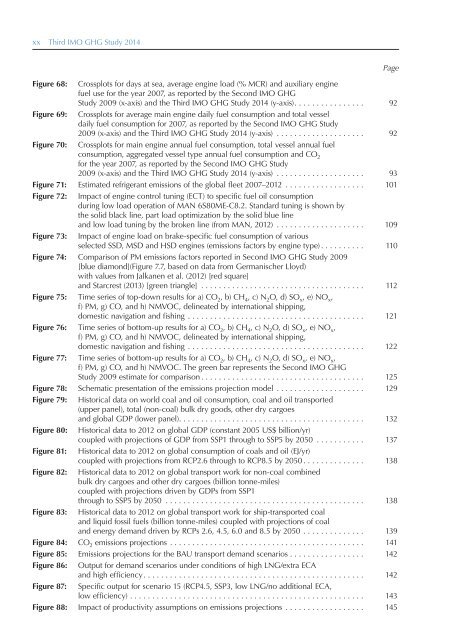Third IMO Greenhouse Gas Study 2014
GHG3%20Executive%20Summary%20and%20Report
GHG3%20Executive%20Summary%20and%20Report
Create successful ePaper yourself
Turn your PDF publications into a flip-book with our unique Google optimized e-Paper software.
xx <strong>Third</strong> <strong>IMO</strong> GHG <strong>Study</strong> <strong>2014</strong><br />
Page<br />
Figure 68: Crossplots for days at sea, average engine load (% MCR) and auxiliary engine<br />
fuel use for the year 2007, as reported by the Second <strong>IMO</strong> GHG<br />
<strong>Study</strong> 2009 (x-axis) and the <strong>Third</strong> <strong>IMO</strong> GHG <strong>Study</strong> <strong>2014</strong> (y-axis) ................ 92<br />
Figure 69: Crossplots for average main engine daily fuel consumption and total vessel<br />
daily fuel consumption for 2007, as reported by the Second <strong>IMO</strong> GHG <strong>Study</strong><br />
2009 (x-axis) and the <strong>Third</strong> <strong>IMO</strong> GHG <strong>Study</strong> <strong>2014</strong> (y-axis) .................... 92<br />
Figure 70: Crossplots for main engine annual fuel consumption, total vessel annual fuel<br />
consumption, aggregated vessel type annual fuel consumption and CO 2<br />
for the year 2007, as reported by the Second <strong>IMO</strong> GHG <strong>Study</strong><br />
2009 (x-axis) and the <strong>Third</strong> <strong>IMO</strong> GHG <strong>Study</strong> <strong>2014</strong> (y-axis) .................... 93<br />
Figure 71: Estimated refrigerant emissions of the global fleet 2007–2012 .................. 101<br />
Figure 72: Impact of engine control tuning (ECT) to specific fuel oil consumption<br />
during low load operation of MAN 6S80ME-C8.2. Standard tuning is shown by<br />
the solid black line, part load optimization by the solid blue line<br />
and low load tuning by the broken line (from MAN, 2012) .................... 109<br />
Figure 73: Impact of engine load on brake-specific fuel consumption of various<br />
selected SSD, MSD and HSD engines (emissions factors by engine type) .......... 110<br />
Figure 74: Comparison of PM emissions factors reported in Second <strong>IMO</strong> GHG <strong>Study</strong> 2009<br />
[blue diamond](Figure 7.7, based on data from Germanischer Lloyd)<br />
with values from Jalkanen et al. (2012) [red square]<br />
and Starcrest (2013) [green triangle] ..................................... 112<br />
Figure 75: Time series of top-down results for a) CO 2 , b) CH 4 , c) N 2 O, d) SO x , e) NO x ,<br />
f) PM, g) CO, and h) NMVOC, delineated by international shipping,<br />
domestic navigation and fishing ........................................ 121<br />
Figure 76: Time series of bottom-up results for a) CO 2 , b) CH 4 , c) N 2 O, d) SO x , e) NO x ,<br />
f) PM, g) CO, and h) NMVOC, delineated by international shipping,<br />
domestic navigation and fishing ........................................ 122<br />
Figure 77: Time series of bottom-up results for a) CO 2 , b) CH 4 , c) N 2 O, d) SO x , e) NO x ,<br />
f) PM, g) CO, and h) NMVOC. The green bar represents the Second <strong>IMO</strong> GHG<br />
<strong>Study</strong> 2009 estimate for comparison ..................................... 125<br />
Figure 78: Schematic presentation of the emissions projection model .................... 129<br />
Figure 79: Historical data on world coal and oil consumption, coal and oil transported<br />
(upper panel), total (non-coal) bulk dry goods, other dry cargoes<br />
and global GDP (lower panel). . . . . . . . . . . . . . . . . . . . . . . . . . . . . . . . . . . . . . . . . . 132<br />
Figure 80: Historical data to 2012 on global GDP (constant 2005 US$ billion/yr)<br />
coupled with projections of GDP from SSP1 through to SSP5 by 2050 ........... 137<br />
Figure 81: Historical data to 2012 on global consumption of coals and oil (EJ/yr)<br />
coupled with projections from RCP2.6 through to RCP8.5 by 2050 .............. 138<br />
Figure 82: Historical data to 2012 on global transport work for non-coal combined<br />
bulk dry cargoes and other dry cargoes (billion tonne-miles)<br />
coupled with projections driven by GDPs from SSP1<br />
through to SSP5 by 2050 ............................................. 138<br />
Figure 83: Historical data to 2012 on global transport work for ship-transported coal<br />
and liquid fossil fuels (billion tonne-miles) coupled with projections of coal<br />
and energy demand driven by RCPs 2.6, 4.5, 6.0 and 8.5 by 2050 .............. 139<br />
Figure 84: CO 2 emissions projections ............................................ 141<br />
Figure 85: Emissions projections for the BAU transport demand scenarios ................. 142<br />
Figure 86: Output for demand scenarios under conditions of high LNG/extra ECA<br />
and high efficiency .................................................. 142<br />
Figure 87: Specific output for scenario 15 (RCP4.5, SSP3, low LNG/no additional ECA,<br />
low efficiency) ..................................................... 143<br />
Figure 88: Impact of productivity assumptions on emissions projections .................. 145


